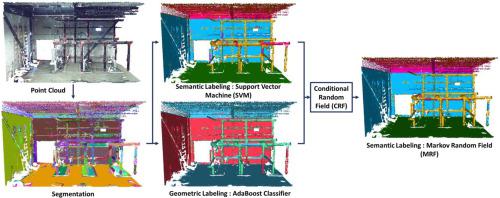Automation in Construction ( IF 10.3 ) Pub Date : 2021-02-12 , DOI: 10.1016/j.autcon.2021.103584 Yeritza Perez-Perez , Mani Golparvar-Fard , Khaled El-Rayes

|
Generating 3D models from point cloud data is a common Virtual Design and Construction (VDC) service. Research has focused on automating several key steps, including segmenting point clouds based on appearance and geometric attributes. These methods dominantly use Manhattan-World assumptions in their approach. Hence, in cases where building systems are close to architectural/structural elements, these methods result in over-segmentation and require significant fine-tuning by the users. To overcome these limitations, this paper presents a learning method based on Markov Random Field (MRF) that assigns semantic labels to point cloud segment. The MRF enforces coherence between the semantic (e.g., beam, column, wall, ceiling, floor, pipe) and geometric labels (e.g., horizontal, vertical, cylindrical), and it uses the neighborhood context to enhance the semantic labeling accuracy. Experimental results show an average accuracy of 90% on semantic labeling, achieving state-of-the-art performance on labeling beam, ceiling, column, floor, pipe, and wall elements.
中文翻译:

通过联合语义和几何特征对点云进行分割,以对建筑环境进行3D建模
从点云数据生成3D模型是一项常见的虚拟设计和构建(VDC)服务。研究集中于自动化几个关键步骤,包括根据外观和几何属性分割点云。这些方法在其方法中主要使用“曼哈顿世界”假设。因此,在建筑系统接近建筑/结构元素的情况下,这些方法导致过度分割,并且需要用户进行大量的微调。为了克服这些限制,本文提出了一种基于马尔可夫随机场(MRF)的学习方法,该方法将语义标签分配给点云段。MRF强制语义(例如,梁,柱,墙,天花板,地板,管道)和几何标签(例如,水平,垂直,圆柱)之间的连贯性,它使用邻域上下文来提高语义标记的准确性。实验结果表明,语义标注的平均准确率达到90%,在标注梁,天花板,圆柱,地板,管道和墙壁元素方面达到了最新水平。



























 京公网安备 11010802027423号
京公网安备 11010802027423号